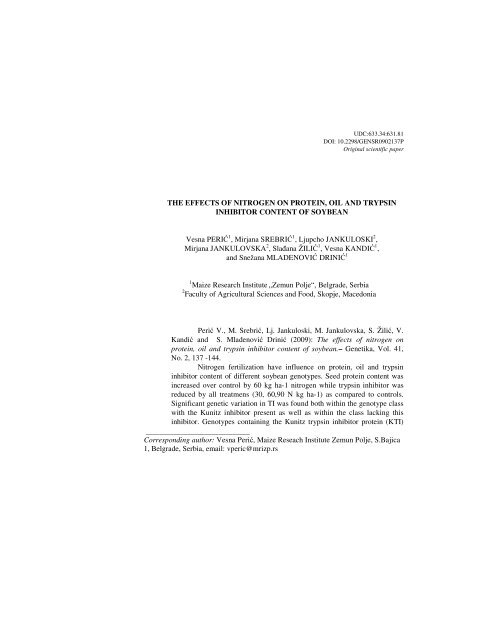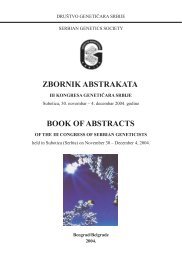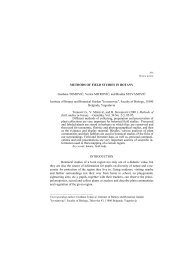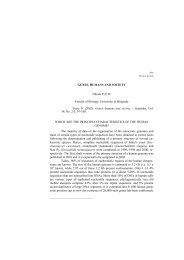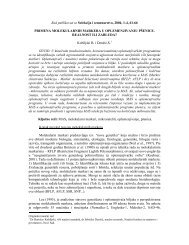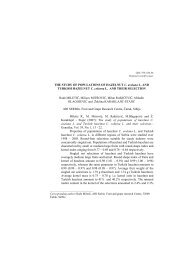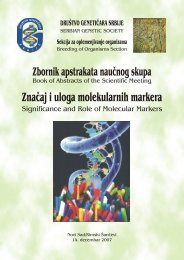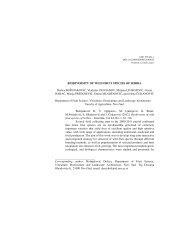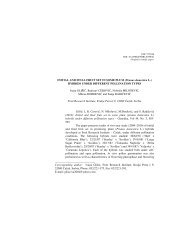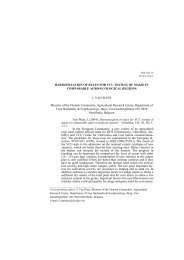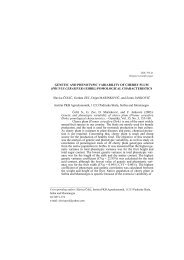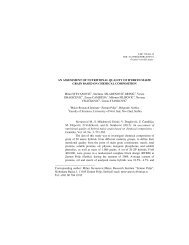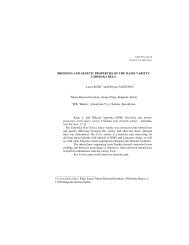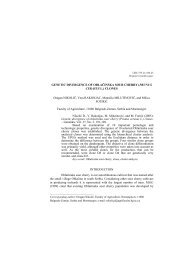Vesna Perić, Maize Reseach Institute Zemun Polje, S ... - doiSerbia
Vesna Perić, Maize Reseach Institute Zemun Polje, S ... - doiSerbia
Vesna Perić, Maize Reseach Institute Zemun Polje, S ... - doiSerbia
Create successful ePaper yourself
Turn your PDF publications into a flip-book with our unique Google optimized e-Paper software.
UDC:633.34:631.81<br />
DOI: 10.2298/GENSR0902137P<br />
Original scientific paper<br />
THE EFFECTS OF NITROGEN ON PROTEIN, OIL AND TRYPSIN<br />
INHIBITOR CONTENT OF SOYBEAN<br />
<strong>Vesna</strong> PERIĆ 1 , Mirjana SREBRIĆ 1 , Ljupcho JANKULOSKI 2 ,<br />
Mirjana JANKULOVSKA 2 , Slađana ŽILIĆ 1 , <strong>Vesna</strong> KANDIĆ 1 ,<br />
and Snežana MLADENOVIĆ DRINIĆ 1<br />
1 <strong>Maize</strong> Research <strong>Institute</strong> „<strong>Zemun</strong> <strong>Polje</strong>“, Belgrade, Serbia<br />
2 Faculty of Agricultural Sciences and Food, Skopje, Macedonia<br />
<strong>Perić</strong> V., M. Srebrić, Lj. Jankuloski, M. Jankulovska, S. Žilić, V.<br />
Kandić and S. Mladenović Drinić (2009): The effects of nitrogen on<br />
protein, oil and trypsin inhibitor content of soybean.– Genetika, Vol. 41,<br />
No. 2, 137 -144.<br />
Nitrogen fertilization have influence on protein, oil and trypsin<br />
inhibitor content of different soybean genotypes. Seed protein content was<br />
increased over control by 60 kg ha-1 nitrogen while trypsin inhibitor was<br />
reduced by all treatmens (30, 60,90 N kg ha-1) as compared to controls.<br />
Significant genetic variation in TI was found both within the genotype class<br />
with the Kunitz inhibitor present as well as within the class lacking this<br />
inhibitor. Genotypes containing the Kunitz trypsin inhibitor protein (KTI)<br />
______________________________<br />
Corresponding author: <strong>Vesna</strong> <strong>Perić</strong>, <strong>Maize</strong> <strong>Reseach</strong> <strong>Institute</strong> <strong>Zemun</strong> <strong>Polje</strong>, S.Bajica<br />
1, Belgrade, Serbia, email: vperic@mrizp.rs
138 GENETIKA, Vol. 41, No. 2, 137-144, 2009.<br />
exhibit a higher TI than genotypes lacking this protein, however, in both<br />
groups of genotypes TI was similary affected by nitrogen application. Oil<br />
content was reduced following nitrogen fertilisation.<br />
Key words: nitrogen, protein, soybean, trypsin inhibitor<br />
INTRODUCTION<br />
Nitrogen is an integral component of many compounds, including<br />
chlorophyll and enzymes, as well as amino acids and related proteins. It is known<br />
that nitrogen is an essential element for achieving high and stable yields and<br />
increased grain proteins. Soybean has one of the highest nitrogen requirements<br />
among the most agronomic crops. Biological fixation and fertilizer N are the main<br />
sources of meeting the N requirement of high-yielding soybeans. As soybean is a<br />
legume crop, symbiotic dinitrogen fixation has a huge impact on soybean quality and<br />
on seed protein content. However, several studies have shown that the symbiotic Nfixation<br />
is not able to meet high N-requirement of this crop particularly under the Ndeficient<br />
conditions. CVIJANOVIC et al, 2007, studied the effects of different rates of<br />
mineral nitrogen as well as soybean seed bacterisation with the symbiotic specieson<br />
yield quality and quantity and found that the mixture of diazotrophs and fertilization<br />
with 40 kg N ha-1 resulted in higher values of studied parameters in soybean. A<br />
number of workers (DURAISAMI and MANI, 2001; KUMAWAT et al., 2000; BACHHAV<br />
and SABALE, 1996; SHARMA and MISRA, 1997) reported the positive role of nitrogen<br />
in increasing yield, protein content and nutrient uptake of soybean.<br />
Mature seeds of soybean contain a number of antinutritional components<br />
with various level of biological activity. Among them, proteinase inhibitors are<br />
considered most important, as they prevent food and feed utilization of raw soybean<br />
and require heat treatment of soybean meal in order to become fully inactivated<br />
(LIENER, 1994). Appropriate agronomic management of soybean crop could reduce<br />
the content of protease inhibitors, which may open new pathways of post harvest<br />
treatment and product utilization. (VOLLMANN et al, 2003).<br />
The aim of the present study was to evaluate the effect of nitrogen on<br />
protein content, oil and trypsin inhibitor activity in four soybean variety.<br />
MATERIALS AND METHODS<br />
Four soybean genotypes were evaluated. Laura and Lana, genotypes lack<br />
the Kunitz type of trypsin inhibitor, were selected by <strong>Maize</strong> Research <strong>Institute</strong>.<br />
Vojvođanka selected by the <strong>Institute</strong> of Field and Vegetable crops, Novi Sad and<br />
Galeb selected by Uljarice, Beograd have standard seed quality. A trail was carried<br />
out on chernozem in the experimental field of the <strong>Maize</strong> Research institute „<strong>Zemun</strong><br />
<strong>Polje</strong>“, at <strong>Zemun</strong> polje, during 2008. Soybean seeds were inoculated with the<br />
bacteria immediately before sowing. The experiment was laid out in a split plot with<br />
five treatments: control, without fertilizer; P60K60 (60 kg ha -1 P2O5 and 60 kg ha -1
V.PERIC et al.: NITROGEN EFFECT ON QUALITY TRAIT OF SOYBEAN 139<br />
K2O, T1), N30P60K60 (30 kg ha -1 N, 60 kg ha -1 P2O5 and 60 kg ha -1 K2O, T2),<br />
N60P60K60 (60 kg ha -1 N, 60 kg ha -1 P2O5 and 60 kg ha -1 K2O, T3), N90P60K60<br />
(90 kg ha -1 N, 60 kg ha -1 P2O5 and 60 kg ha -1 K2O, T4). The intention of these<br />
treatments was to create different conditions in terms of nitrogen supply during seed<br />
filling period which could influence on the expression of seed quality characteristics.<br />
Seed protein and oil contents were determined by near-infrared reflectance<br />
spectroscopy (NIRS) using Infratec 1241 Grain analyzer, (Foss Tecator, Sweden).<br />
The content of trypsin inhibitors was estimated according to a modified Erlanger<br />
method, HAMERSTRAND et al. (1981), using Na-benzoyl-DL-arginine-p-nitroanilide<br />
hydrochloride (BAPA) as substrate. The absorbance was measured at 410nm.<br />
RESULTS AND DISCUSSION<br />
It is know that protein composition varies among genotypes as well as the<br />
levels of trypsin inhibitors (PESIC et al, 2005). However, little information is<br />
available about environmental influences and the effects of nitrogen supply on the<br />
protein and antinutritional constituents of soybean. Seed protein content was<br />
determined in four soybean genotypes grown under different nitrogen treatment. A<br />
considerable variation in soybean seed protein content across different treatments is<br />
presented in Table 1. The average protein content was from 36, 55 in variety<br />
Vojvođanka to 37, 45 in variety Laura. Protein content in seeds of all analyzed<br />
genotypes was progressively increased with increasing levels of nitrogen up to 60 kg<br />
N ha -1 . Laura has the highest protein content in all treatments. Increase in protein<br />
content of soybean with increasing level of nitrogen was also reported by many<br />
workers (MORSHED et al., 2008; EMAN, 2002; KUMAWAT et al., 2000; BACHHAV and<br />
SABALE, 1996, EL-SHAMY et al, 2001).<br />
The availability of nitrogen during the seed-filling period is important<br />
prerequisite of high seed protein content. PEAK et al, (1997) demonstrated that the<br />
increase in seed protein content after late nitrogen application was associated with<br />
poorer protein quality, because the low-sulphur beta subunit of 7S protein was more<br />
strongly expressed than other fraction of seed storage protein. According to VOLMAN<br />
et al. (2000), nitrogen fertilization at the flowering stage was superior to control and<br />
rhizobium inoculation in increasing seed protein content in a set of genotype. The<br />
low magnitude of interaction between genotypes and nitrogen treatment in seed<br />
quality characters suggests that different genotypes would react similarly to those<br />
management variants and that selection of genotypes would give similar results<br />
under each of the nitrogen treatments.<br />
MORSHAD et al. (2008) found that nitrogen uptake by seeds increased with<br />
increasing level of N up to certain level. DURAISAMI and MANI (2001) found that the<br />
uptake of N by soybean was favorably affected by the residual effect of N levels.<br />
KUMAWAT et al. (2000) reported that the N uptake by seeds of soybean significantly<br />
increased with the increase in N up to 60 kg ha -1 .
140 GENETIKA, Vol. 41, No. 2, 137-144, 2009.<br />
Table 1. Protein, oil and trypsin inhibitor content of soybean seed under different N<br />
treatments<br />
Genotype / treatment<br />
Proteins %<br />
Oil %<br />
Total N %<br />
Trypsin<br />
inhibitor mgg -1<br />
Vojvođanka P60 K60 36,49 19,98 5,92 31,04<br />
Vojvođanka N30 P60 K60 36,57 19,94 6,00 30,07<br />
Vojvođanka N60 P60 K60 36,89 19,89 6,06 29,9<br />
Vojvođanka N90 P60 K60 36,77 19,89 5,92 29,37<br />
Vojvođankla control 36,02 20,01 5,83 31,21<br />
average 36,55 19,94 5,95 30,32<br />
Lana P60 K60 36,57 21,3 6,12 15,26<br />
Lana N30 P60 K60 36,75 21,2 6,13 15,24<br />
Lana N60 P60 K60 37,18 21,05 6,18 14,67<br />
Lana N90 P60 K60 36,58 21,34 6,20 14,54<br />
Lana control 36,56 21,43 6,12 15,35<br />
average 36,73 21,26 6,15 15,01<br />
Laura P60 K60 37,37 19,53 6,22 14,73<br />
Laura N30 P60 K60 37,42 19,51 6,25 14,38<br />
Laura N60 P60 K60 37,64 19,22 6,28 14,28<br />
Laura N90 P60 K60 37,51 19,57 6,43 14,05<br />
Laura control 37,31 19,62 6,18 15,01<br />
average 37,45 19,49 6,27 14,49<br />
Galeb P60 K60 37,34 19,95 6,14 29,85<br />
Galeb N30 P60 K60 37,4 19,92 6,17 29,49<br />
Galeb N60 P60 K60 37,56 19,91 6,22 29,25<br />
Galeb N90 P60 K60 37,38 19,93 6,20 29,01<br />
Galeb control 37,28 19,98 6,11 30,25<br />
average 37,39 19,94 6,17 29,57<br />
Nitrogen concentration in soybean seed is also under genetic control (BRIM<br />
and BURTON, 1979). Total seed N ranged from 5, 83% in Vojvođanka to 6, 18% in<br />
Laura. Slightly changes in the amount of N in seed were found with varying amount<br />
of N fertilizer.<br />
Apart from seed protein content, oil and trypsin inhibitor content were also<br />
influenced by the nitrogen regime. Protein and oil content are negatively correlated<br />
(BURTON, 1985) and the protein content shows more variability than oil content<br />
(WEILENMANN and LUQUEZ, 1999). Seed oil content decreased while seed protein<br />
content increased with increased amounts of applied nitrogen thereby supporting<br />
previous findings (BLAMEY & CHAPMEN, 1981, LOUBSER & GRIMBEEK, 1985, STEER<br />
et al., 1986).<br />
The presence of protease inhibitors in soybean prohibits the utilization of<br />
the raw beans for food and feed. Two major classes of protease inhibitors are present
V.PERIC et al.: NITROGEN EFFECT ON QUALITY TRAIT OF SOYBEAN 141<br />
in soybean seeds, the Kunitz trypsin inhibitor and the Bowman-Birk inhibitor. In<br />
agronomic and plant breeding research trypsin inhibitor activity has rarely been<br />
monitored in field trails, although it could be treated as a quantitative characteristic<br />
and target for selection. Laura and Lana, genotypes lack the Kunitz type of trypsin<br />
inhibitor, were selected by <strong>Maize</strong> Research institute. Another two genotypes,<br />
Vojvođanka and Galeb, have standard trypsin inhibitor concentration. The trypsin<br />
inhibitor content of the studied genotypes is shown in Table 1. The investigated<br />
soybean varieties displayed different TI level. As expected, the lowest TI content<br />
was detected in Laura and Lana, a KTI-lacking cultivar. Trypsin inhibitor activity<br />
was influenced by the applied treatments. TI concentration of different genotypes<br />
under different N treatments is presented in Fig 1. Genotypes containing the Kunitz<br />
trypsin inhibitor protein (KTI) exhibit a higher TI than genotypes lacking this protein<br />
but in both groups of genotypes TI was similarly affected by nitrogen application.<br />
VOLLMAN et al (2003) found that TI was reduced by nitrogen or nitroge+sulphur<br />
application. Soybean genotypes segregated according to the presence or absence of<br />
the Kunitz trypsin inhibitor has been evaluated for trypsin inhibitor activity (TIA) in<br />
field trials. The authors found that TIA was affected significantly by environment<br />
(geographical location), fertilization treatment and genotype. Nitrogen application,<br />
which caused an increase in seed protein content, resulted in a reduction in TIA by<br />
about 15% as compared with the control. PAEK (1997) demonstrated that the lowsulphur<br />
subunits of 7S protein are more strongly expressed than other fractions of<br />
soybean seed storage proteins at late nitrogen application.<br />
Fig1. Trypsin inhibitor activity under different N treatments<br />
Many studies have shown an increase in yield and associated dry matter<br />
accumulation as a result of nitrogen application to soybean (AFZA et al., 1987;<br />
MICHAEL et al., 2001; OSBORNE and RIEDELL, 2006; WOOD et al., 1993). In our study<br />
the seed yield was increased with increasing rates of N application up to 60 kg ha-1
142 GENETIKA, Vol. 41, No. 2, 137-144, 2009.<br />
and there after it reduced (date no shown). REDDY et al (1990) reported that<br />
application of 60 kg ha -1 resulted in highest seed yield of soybean. According to<br />
BOROOMANNDAN et al., (2009) seed yield was significantly increased in 40 kg Nha -1<br />
application compared to control but application of 80 kg N ha -1 decreased seed yield.<br />
CONCLUSION<br />
Soybean seed quality and seed protein content in particular, is subject to<br />
considerable variation which may affect the processing value of the soybean. So<br />
father research is necessary in order to fine-tune soybean nutrition towards achieving<br />
a high quality soybean production.<br />
ACKNOWLEDGMENTS<br />
This investigation was supported by the Ministry of science and technology of<br />
Serbia, thought project TR 20114.<br />
REFERENCES<br />
Received April 09 th , 2009<br />
Accepted June 18 th , 2009<br />
AFZA, R., G. HARDARSON, F. ZAPATA, and S.K.A. DANSO (1987): Effects of delayed soil and foliar N<br />
fertilization on yield and N2 fixation of soybean. Plant Soil 97, 361–368.<br />
BACHHAV, P. R. and R. N. SABALE (1996): Effects of different sources of nitrogen on growth parameters,<br />
yield and quality of soybean. J Maharashtra Agric Univ 21(2), 244-247.<br />
BLAMEY, F.P.C., and J. CHAPMAN (1981): Protein, oil, and energy yields as affected by N and P<br />
fertilization. Agron. J., 73, 583-587<br />
BOROOMANDAN, P., M. KHORAMIVAFA, Y. HAGHI, and A. EBRAHIMI (2009): The effects of nitrogen starter<br />
fertilizer and plant density on yield, yield components and oli and protein content of soybean<br />
(Glycine max, Merr.). Pakistan Journal of biological sciences, vol 12, 4, 378-382.<br />
BRIM, C.A. and J.W. BURTON (1979): Reccurent selection in soybeans. II. Selection for increased percent<br />
proteins in seeds. Crop Sci. 19: 494-498<br />
BURTON, J.W. (1985): Breeding soybeans for improved protein quantity and quality. Iin Shibles, R. (ed).<br />
World soybean research III. Proceedings. Westview press, Boulder and London.<br />
CVIJANOVIC, G., N. MILOŠEVIC and M. JARAK (2007): The importance of diazotrophs as biofertilisers in the<br />
maize and soybean production. - Genetika, Vol 39, No. 3, 395-404.<br />
DURAISAMI, V. P. and A. K. MANI (2001): Residual effect of inorganic nitrogen, composted coirpith and<br />
biofertilizer on yield and uptake of soybean in an Inceptisol. Madras Agric J 88(4/6), 277-280.<br />
EL-SHEMY, H., S. RYU, K. FUJITA (2001): Subunit composition of storage proteins in soybean seeds as<br />
affected by nitrogen applicaton and pod removal. American Biotechnology Laboratory<br />
2001Vol.19,No.1.
V.PERIC et al.: NITROGEN EFFECT ON QUALITY TRAIT OF SOYBEAN 143<br />
EMAN, S. S. (2002):. Response of growth, yield and attributes of soybean plants [(Glycin max (L.) Merr.)]<br />
to late soil nitrogen fertilization. Arab Univ J Agric Sci 10(1), 165-172.<br />
HAMERSTRAND, G. E., L. T. BLACK, and J. D. GLOVER (1981): Trypsin inhibitors in soy products:<br />
Modification of the standard analytical procedure. Cereal Chem. 58:42–45.<br />
KUMAWAT, S. M., L. L. DHAKAR, and P. L. MALIWAL (2000): Effect of irrigation regimes and nitrogen on<br />
yield, oil content and nutrient uptake of soybean (Glycine max). Indian J Agron 45(2), 361-<br />
366.<br />
LIENER, I.E. (1994): Implications of antinutritional components in soybean foods. Crit Rew Food Sci Nutr<br />
34.31-67.<br />
LOUBSER, H.L., C.L. GRIMBEEK, A.S. ROBERTSON, B.BRONKHORST, C.SERFONTEIN and J.C.VAN DER SANDT<br />
(1987): Effect of plant population on sunflower seed yield. Field Crop Abstracts Vol. 40 No:<br />
8.<br />
MICHAEL, A.S., J.A. LAMB, G.W. RANDALL, J.H.ORFC and G.W. REHMA (2001): IN-eason fertilizer nitrogen<br />
applications for soybean in Minnesota. Agron. J., 93, 983-988.<br />
MORSHED, R.M., M.M. RAHMAN, and M.A. RAHMAN (2008): Effect of nitrogen on seed yield, protein<br />
content and nutrient uptake of soybean (Glycine max L.). J Agric Rurak Dev 6 (1&2), 13-17.<br />
OSBORNE, S.L., and W.E. RIEDELL ( 2006): Soybean growth response to low rates of nitrogen applied at<br />
planting in the northern great plains. Journal of Plant Nutrition. 29:985-1002.<br />
PAEK, N.C., J. IMSANDE, R.C. SHOEMAKER and R. SHIBLES (1997): Nutritional control of soybean seed<br />
storage protein. Crop Sci 37:498-503.<br />
PEŠIĆ, M.B., B.V. VUCELIC-RADOVIC, M.B. BARAC, and S.P STANOJEVIC (2005): The influence of genotypic<br />
variation in protein composition on emulsifyinf properties of soy proteins. J.Am.Oil Chem.<br />
Soc. 82, 667-672.<br />
REDDY, T. R., M. RAO, and K. R. RAO (1990): Response of soybean (Glycine max L) to nitrogen and<br />
phosphorus. Indian J Agron 35, 310-311.<br />
SHARMA, R. A. and O. R. MISRA (1997): Crop residues, FYM and fertilizer use in relation to growth, yield<br />
and nutrient uptake by soybean. Crop Res Hisar 13(1), 51-57.<br />
STEER, B.T., P.D. COALDRAKE, C..J PEARSON, and P.J. CANTY (1986): Effects of nitrogen supply and<br />
population density on plant development and yield components of irrigated sunflower<br />
(Helianthus annuus L.). Field Crops Research 13: 99-115.<br />
VOLLMANN, J., C. FRITZ, H. WAGENTRISTL, and P. RUCKENBAUER (2000):Environmental and genetic<br />
variation of soybean seed protein content under Central European growing conditions. J Sci<br />
Food Agric 80:1300-1306<br />
VOLLMANN, J., H. GRAUSGRUBER, H. WAGENTRISTL, H. WOHLESER and P. MICHELE (2003): Trypsin<br />
inhibitor activity of soybean as affected by genotype and fertilization. J.Sci Food.Agric 83:<br />
1581-1586.<br />
WEILENMANN DE TAU, M.E. and J. LUQUEZ (1999): Variability of oil and protein contents of commercial<br />
cultivars (group IV) in Argentina. Tests of agrichemicals and cultivars vol 20: 62-63.<br />
WOOD, C.W., H.A. TORBERT, and D.B. WEAVER (1993): Nitrogen fertilizer effects on soybean growth, yield,<br />
and seed composition. J. Prod. Agric. 6, 354–360.
144 GENETIKA, Vol. 41, No. 2, 137-144, 2009.<br />
UTICAJ AZOTA NA SADRŽAJ PROTEINA, ULJA<br />
I TRIPSIN INHIBITORA U ZRNU SOJE<br />
<strong>Vesna</strong> PERIĆ 1 , Mirjana SREBRIĆ 1 , Ljupcho JANKULOSKI 2 ,<br />
Mirjana JANKULOVSKA 2 , Slađana ŽILIĆ 1 , <strong>Vesna</strong> KANDIĆ 1<br />
i Snežana MLADENOVIĆ DRINIĆ 1<br />
1 Institut za kukuruz„<strong>Zemun</strong> <strong>Polje</strong>“, Beograd, Srbija<br />
2 Poljoprivredni fakultet, Skopje, Makedonija<br />
I z v o d<br />
Đubrenje azotom ima uticaj na sadržaj proteina, ulja i tripsin inhibitora u<br />
zrnu različitih genotipova soje. Sadržaj proteina se povećao iznad vrednosti kontrole<br />
primenom 60 kg ha -1 dok se sadržaj tripsin inhibitora smanjio u svim tretmanima (30,<br />
60, 90 N kg ha -1 ) u poređenju sa kontrolom. Značajno genetičko variranje tripsin<br />
inhibitora je utvrđeno unutargenotipova koji sadrže Kunic tripsin inhibitor kao i<br />
genotipova bez ovog inhibitora. Genotipovi koji sadrže KTI su ispoljili veće<br />
vrednosti za tripsin inhibitore nego genotipovi bez ovog proteina, dok je kod obe<br />
grupe genotipova uticaj azota na sadržaj tripsin inhibitora bio isti. Sadržaj ulja se<br />
smanjio nakon primene azotnog đubriva.<br />
Primljeno 09. IV 2009.<br />
Odobreno 18. VI. 2009.


